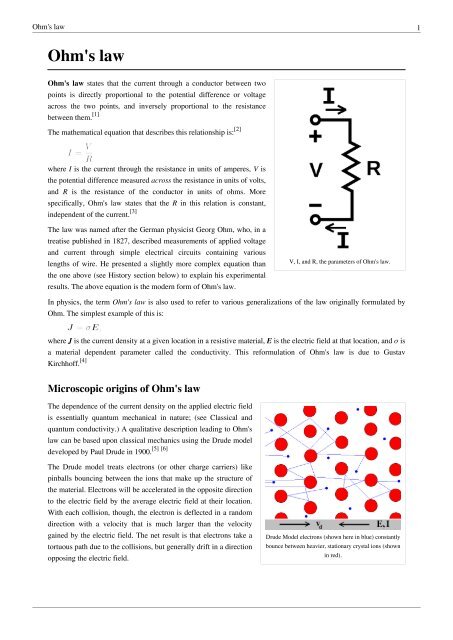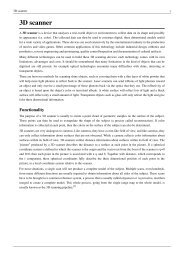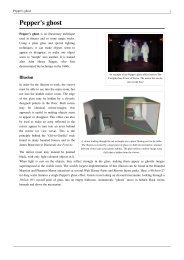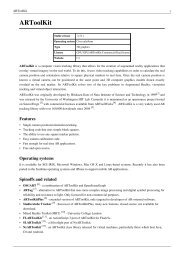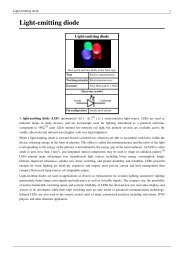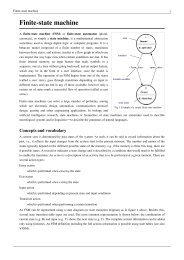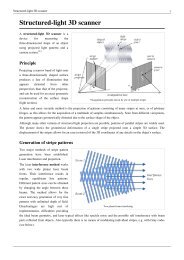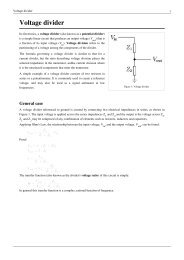Ohm's law - Wikipedia, the free encyclopedia.pdf - Ex-ch.com
Ohm's law - Wikipedia, the free encyclopedia.pdf - Ex-ch.com
Ohm's law - Wikipedia, the free encyclopedia.pdf - Ex-ch.com
You also want an ePaper? Increase the reach of your titles
YUMPU automatically turns print PDFs into web optimized ePapers that Google loves.
<strong>Ohm's</strong> <strong>law</strong> 1<br />
<strong>Ohm's</strong> <strong>law</strong><br />
<strong>Ohm's</strong> <strong>law</strong> states that <strong>the</strong> current through a conductor between two<br />
points is directly proportional to <strong>the</strong> potential difference or voltage<br />
across <strong>the</strong> two points, and inversely proportional to <strong>the</strong> resistance<br />
between <strong>the</strong>m. [1]<br />
The ma<strong>the</strong>matical equation that describes this relationship is: [2]<br />
where I is <strong>the</strong> current through <strong>the</strong> resistance in units of amperes, V is<br />
<strong>the</strong> potential difference measured across <strong>the</strong> resistance in units of volts,<br />
and R is <strong>the</strong> resistance of <strong>the</strong> conductor in units of ohms. More<br />
specifically, <strong>Ohm's</strong> <strong>law</strong> states that <strong>the</strong> R in this relation is constant,<br />
independent of <strong>the</strong> current. [3]<br />
The <strong>law</strong> was named after <strong>the</strong> German physicist Georg Ohm, who, in a<br />
treatise published in 1827, described measurements of applied voltage<br />
and current through simple electrical circuits containing various<br />
lengths of wire. He presented a slightly more <strong>com</strong>plex equation than<br />
<strong>the</strong> one above (see History section below) to explain his experimental<br />
results. The above equation is <strong>the</strong> modern form of <strong>Ohm's</strong> <strong>law</strong>.<br />
V, I, and R, <strong>the</strong> parameters of <strong>Ohm's</strong> <strong>law</strong>.<br />
In physics, <strong>the</strong> term <strong>Ohm's</strong> <strong>law</strong> is also used to refer to various generalizations of <strong>the</strong> <strong>law</strong> originally formulated by<br />
Ohm. The simplest example of this is:<br />
where J is <strong>the</strong> current density at a given location in a resistive material, E is <strong>the</strong> electric field at that location, and σ is<br />
a material dependent parameter called <strong>the</strong> conductivity. This reformulation of <strong>Ohm's</strong> <strong>law</strong> is due to Gustav<br />
Kir<strong>ch</strong>hoff. [4]<br />
Microscopic origins of <strong>Ohm's</strong> <strong>law</strong><br />
The dependence of <strong>the</strong> current density on <strong>the</strong> applied electric field<br />
is essentially quantum me<strong>ch</strong>anical in nature; (see Classical and<br />
quantum conductivity.) A qualitative description leading to <strong>Ohm's</strong><br />
<strong>law</strong> can be based upon classical me<strong>ch</strong>anics using <strong>the</strong> Drude model<br />
[5] [6]<br />
developed by Paul Drude in 1900.<br />
The Drude model treats electrons (or o<strong>the</strong>r <strong>ch</strong>arge carriers) like<br />
pinballs bouncing between <strong>the</strong> ions that make up <strong>the</strong> structure of<br />
<strong>the</strong> material. Electrons will be accelerated in <strong>the</strong> opposite direction<br />
to <strong>the</strong> electric field by <strong>the</strong> average electric field at <strong>the</strong>ir location.<br />
With ea<strong>ch</strong> collision, though, <strong>the</strong> electron is deflected in a random<br />
direction with a velocity that is mu<strong>ch</strong> larger than <strong>the</strong> velocity<br />
gained by <strong>the</strong> electric field. The net result is that electrons take a<br />
tortuous path due to <strong>the</strong> collisions, but generally drift in a direction<br />
opposing <strong>the</strong> electric field.<br />
Drude Model electrons (shown here in blue) constantly<br />
bounce between heavier, stationary crystal ions (shown<br />
in red).
<strong>Ohm's</strong> <strong>law</strong> 2<br />
The drift velocity <strong>the</strong>n determines <strong>the</strong> electric current density and its relationship to E and is independent of <strong>the</strong><br />
collisions. Drude calculated <strong>the</strong> average drift velocity from p = −eEτ where p is <strong>the</strong> average momentum, −e is <strong>the</strong><br />
<strong>ch</strong>arge of <strong>the</strong> electron and τ is <strong>the</strong> average time between <strong>the</strong> collisions. Since both <strong>the</strong> momentum and <strong>the</strong> current<br />
density are proportional to <strong>the</strong> drift velocity, <strong>the</strong> current density be<strong>com</strong>es proportional to <strong>the</strong> applied electric field;<br />
this leads to <strong>Ohm's</strong> <strong>law</strong>.<br />
Hydraulic analogy<br />
A hydraulic analogy is sometimes used to describe <strong>Ohm's</strong> Law. Water pressure, measured by pascals (or PSI), is <strong>the</strong><br />
analog of voltage because establishing a water pressure difference between two points along a (horizontal) pipe<br />
causes water to flow. Water flow rate, as in liters per second, is <strong>the</strong> analog of current, as in coulombs per second.<br />
Finally, flow restrictors — su<strong>ch</strong> as apertures placed in pipes between points where <strong>the</strong> water pressure is measured —<br />
are <strong>the</strong> analog of resistors. We say that <strong>the</strong> rate of water flow through an aperture restrictor is proportional to <strong>the</strong><br />
difference in water pressure across <strong>the</strong> restrictor. Similarly, <strong>the</strong> rate of flow of electrical <strong>ch</strong>arge, that is, <strong>the</strong> electric<br />
current, through an electrical resistor is proportional to <strong>the</strong> difference in voltage measured across <strong>the</strong> resistor.<br />
[7] [8]<br />
Flow and pressure variables can be calculated in fluid flow network with <strong>the</strong> use of <strong>the</strong> hydraulic ohm analogy.<br />
The method can be applied to both steady and transient flow situations. In <strong>the</strong> linear laminar flow region, Poiseuille's<br />
<strong>law</strong> describes <strong>the</strong> hydraulic resistance of a pipe, but in <strong>the</strong> turbulent flow region <strong>the</strong> pressure–flow relations be<strong>com</strong>e<br />
nonlinear.<br />
Circuit analysis<br />
In circuit analysis, three equivalent expressions of <strong>Ohm's</strong> <strong>law</strong> are used<br />
inter<strong>ch</strong>angeably:<br />
<strong>Ohm's</strong> <strong>law</strong> triangle<br />
Indeed, ea<strong>ch</strong> is quoted by some sources as <strong>the</strong> defining relationship of <strong>Ohm's</strong> <strong>law</strong>, [2] [9] [10] or all three are quoted, [11]<br />
or derived from a proportional form, [12] or even just <strong>the</strong> two that do not correspond to <strong>Ohm's</strong> original statement may<br />
[13] [14]<br />
sometimes be given.<br />
The inter<strong>ch</strong>angeability of <strong>the</strong> equation may be represented by a triangle, where V (voltage) is placed on <strong>the</strong> top<br />
section, <strong>the</strong> I (current) is placed to <strong>the</strong> left section, and <strong>the</strong> R (resistance) is placed to <strong>the</strong> right. The line that divides<br />
<strong>the</strong> left and right sections indicate multiplication, and <strong>the</strong> divider between <strong>the</strong> top and bottom sections indicates<br />
division (hence <strong>the</strong> division bar).<br />
Resistive circuits<br />
Resistors are circuit elements that impede <strong>the</strong> passage of electric <strong>ch</strong>arge in agreement with <strong>Ohm's</strong> <strong>law</strong>, and are<br />
designed to have a specific resistance value R. In a s<strong>ch</strong>ematic diagram <strong>the</strong> resistor is shown as a zig-zag symbol. An<br />
element (resistor or conductor) that behaves according to <strong>Ohm's</strong> <strong>law</strong> over some operating range is referred to as an<br />
ohmic device (or an ohmic resistor) because <strong>Ohm's</strong> <strong>law</strong> and a single value for <strong>the</strong> resistance suffice to describe <strong>the</strong><br />
behavior of <strong>the</strong> device over that range.
<strong>Ohm's</strong> <strong>law</strong> 3<br />
<strong>Ohm's</strong> <strong>law</strong> holds for circuits containing only resistive elements (no capacitances or inductances) for all forms of<br />
driving voltage or current, regardless of whe<strong>the</strong>r <strong>the</strong> driving voltage or current is constant (DC) or time-varying su<strong>ch</strong><br />
as AC. At any instant of time <strong>Ohm's</strong> <strong>law</strong> is valid for su<strong>ch</strong> circuits.<br />
Resistors whi<strong>ch</strong> are in series or in parallel may be grouped toge<strong>the</strong>r into a single "equivalent resistance" in order to<br />
apply <strong>Ohm's</strong> <strong>law</strong> in analyzing <strong>the</strong> circuit. This application of <strong>Ohm's</strong> <strong>law</strong> is illustrated with examples in "How To<br />
Analyze Resistive Circuits Using <strong>Ohm's</strong> Law" on wikiHow.<br />
Reactive circuits with time-varying signals<br />
When reactive elements su<strong>ch</strong> as capacitors, inductors, or transmission lines are involved in a circuit to whi<strong>ch</strong> AC or<br />
time-varying voltage or current is applied, <strong>the</strong> relationship between voltage and current be<strong>com</strong>es <strong>the</strong> solution to a<br />
differential equation, so <strong>Ohm's</strong> <strong>law</strong> (as defined above) does not directly apply since that form contains only<br />
resistances having value R, not <strong>com</strong>plex impedances whi<strong>ch</strong> may contain capacitance ("C") or inductance ("L").<br />
Equations for time-invariant AC circuits take <strong>the</strong> same form as <strong>Ohm's</strong> <strong>law</strong>, however, <strong>the</strong> variables are generalized to<br />
<strong>com</strong>plex numbers and <strong>the</strong> current and voltage waveforms are <strong>com</strong>plex exponentials. [15]<br />
In this approa<strong>ch</strong>, a voltage or current waveform takes <strong>the</strong> form , where t is time, s is a <strong>com</strong>plex parameter, and<br />
A is a <strong>com</strong>plex scalar. In any linear time-invariant system, all of <strong>the</strong> currents and voltages can be expressed with <strong>the</strong><br />
same s parameter as <strong>the</strong> input to <strong>the</strong> system, allowing <strong>the</strong> time-varying <strong>com</strong>plex exponential term to be canceled out<br />
and <strong>the</strong> system described algebraically in terms of <strong>the</strong> <strong>com</strong>plex scalars in <strong>the</strong> current and voltage waveforms.<br />
The <strong>com</strong>plex generalization of resistance is impedance, usually denoted Z; it can be shown that for an inductor,<br />
and for a capacitor,<br />
We can now write,<br />
where V and I are <strong>the</strong> <strong>com</strong>plex scalars in <strong>the</strong> voltage and current respectively and Z is <strong>the</strong> <strong>com</strong>plex impedance.<br />
This form of <strong>Ohm's</strong> <strong>law</strong>, with Z taking <strong>the</strong> place of R, generalizes <strong>the</strong> simpler form. When Z is <strong>com</strong>plex, only <strong>the</strong> real<br />
part is responsible for dissipating heat.<br />
In <strong>the</strong> general AC circuit, Z varies strongly with <strong>the</strong> frequency parameter s, and so also will <strong>the</strong> relationship between<br />
voltage and current.<br />
For <strong>the</strong> <strong>com</strong>mon case of a steady sinusoid, <strong>the</strong> s parameter is taken to be , corresponding to a <strong>com</strong>plex sinusoid<br />
. The real parts of su<strong>ch</strong> <strong>com</strong>plex current and voltage waveforms describe <strong>the</strong> actual sinusoidal currents and<br />
voltages in a circuit, whi<strong>ch</strong> can be in different phases due to <strong>the</strong> different <strong>com</strong>plex scalars.<br />
Linear approximations<br />
<strong>Ohm's</strong> <strong>law</strong> is one of <strong>the</strong> basic equations used in <strong>the</strong> analysis of electrical circuits. It applies to both metal conductors<br />
and circuit <strong>com</strong>ponents (resistors) specifically made for this behaviour. Both are ubiquitous in electrical engineering.<br />
Materials and <strong>com</strong>ponents that obey <strong>Ohm's</strong> <strong>law</strong> are described as "ohmic" [16] whi<strong>ch</strong> means <strong>the</strong>y produce <strong>the</strong> same<br />
value for resistance (R = V/I) regardless of <strong>the</strong> value of V or I whi<strong>ch</strong> is applied and whe<strong>the</strong>r <strong>the</strong> applied voltage or<br />
current is DC (direct current) of ei<strong>the</strong>r positive or negative polarity or AC (alternating current).<br />
In a true ohmic device, <strong>the</strong> same value of resistance will be calculated from R = V/I regardless of <strong>the</strong> value of <strong>the</strong><br />
applied voltage V. That is, <strong>the</strong> ratio of V/I is constant, and when current is plotted as a function of voltage <strong>the</strong> curve<br />
is linear (a straight line). If voltage is forced to some value V, <strong>the</strong>n that voltage V divided by measured current I will<br />
equal R. Or if <strong>the</strong> current is forced to some value I, <strong>the</strong>n <strong>the</strong> measured voltage V divided by that current I is also R.
<strong>Ohm's</strong> <strong>law</strong> 4<br />
Since <strong>the</strong> plot of I versus V is a straight line, <strong>the</strong>n it is also true that for any set of two different voltages V 1 and V 2<br />
applied across a given device of resistance R, producing currents I 1 = V 1 /R and I 2 = V 2 /R, that <strong>the</strong> ratio<br />
(V 1 -V 2 )/(I 1 -I 2 ) is also a constant equal to R. The operator "delta" (Δ) is used to represent a difference in a quantity,<br />
so we can write ΔV = V 1 -V 2 and ΔI = I 1 -I 2 . Summarizing, for any truly ohmic device having resistance R, V/I =<br />
ΔV/ΔI = R for any applied voltage or current or for <strong>the</strong> difference between any set of applied voltages or currents.<br />
There are, however, <strong>com</strong>ponents of electrical circuits<br />
whi<strong>ch</strong> do not obey <strong>Ohm's</strong> <strong>law</strong>; that is, <strong>the</strong>ir relationship<br />
between current and voltage (<strong>the</strong>ir I–V curve) is nonlinear.<br />
An example is <strong>the</strong> p-n junction diode (curve at right). As<br />
seen in <strong>the</strong> figure, <strong>the</strong> current does not increase linearly<br />
with applied voltage for a diode. One can determine a<br />
value of current (I) for a given value of applied voltage (V)<br />
from <strong>the</strong> curve, but not from <strong>Ohm's</strong> <strong>law</strong>, since <strong>the</strong> value of<br />
"resistance" is not constant as a function of applied<br />
voltage. Fur<strong>the</strong>r, <strong>the</strong> current only increases significantly if<br />
<strong>the</strong> applied voltage is positive, not negative. The ratio V/I<br />
for some point along <strong>the</strong> nonlinear curve is sometimes<br />
called <strong>the</strong> static, or <strong>ch</strong>ordal, or DC, resistance [17] [18] , but<br />
Plot of I–V curve of an ideal p-n junction diode at 1μA reverse<br />
leakage current. Failure of <strong>the</strong> device to follow <strong>Ohm's</strong> <strong>law</strong> is<br />
clearly shown since <strong>the</strong> curve is not a straight line.<br />
as seen in <strong>the</strong> figure <strong>the</strong> value of total V over total I varies depending on <strong>the</strong> particular point along <strong>the</strong> nonlinear<br />
curve whi<strong>ch</strong> is <strong>ch</strong>osen. This means <strong>the</strong> "DC resistance" V/I at some point on <strong>the</strong> curve is not <strong>the</strong> same as what would<br />
be determined by applying an AC signal having peak amplitude ΔV volts or ΔI amps centered at that same point<br />
along <strong>the</strong> curve and measuring ΔV/ΔI. However, in some diode applications, <strong>the</strong> AC signal applied to <strong>the</strong> device is<br />
small and it is possible to analyze <strong>the</strong> circuit in terms of <strong>the</strong> dynamic, small-signal, or incremental resistance, defined<br />
as <strong>the</strong> one over <strong>the</strong> slope of <strong>the</strong> V–I curve at <strong>the</strong> average value (DC operating point) of <strong>the</strong> voltage (that is, one over<br />
<strong>the</strong> derivative of current with respect to voltage). For sufficiently small signals, <strong>the</strong> dynamic resistance allows <strong>the</strong><br />
<strong>Ohm's</strong> <strong>law</strong> small signal resistance to be calculated as approximately one over <strong>the</strong> slope of a line drawn tangentially to<br />
<strong>the</strong> V-I curve at <strong>the</strong> DC operating point. [19]<br />
Temperature effects<br />
<strong>Ohm's</strong> <strong>law</strong> has sometimes been stated as, "for a conductor in a given state, <strong>the</strong> electromotive force is proportional to<br />
<strong>the</strong> current produced." That is, that <strong>the</strong> resistance, <strong>the</strong> ratio of <strong>the</strong> applied electromotive force (or voltage) to <strong>the</strong><br />
current, "does not vary with <strong>the</strong> current strength ." The qualifier "in a given state" is usually interpreted as meaning<br />
"at a constant temperature," since <strong>the</strong> resistivity of materials is usually temperature dependent. Because <strong>the</strong><br />
conduction of current is related to Joule heating of <strong>the</strong> conducting body, according to Joule's first <strong>law</strong>, <strong>the</strong><br />
temperature of a conducting body may <strong>ch</strong>ange when it carries a current. The dependence of resistance on<br />
temperature <strong>the</strong>refore makes resistance depend upon <strong>the</strong> current in a typical experimental setup, making <strong>the</strong> <strong>law</strong> in<br />
this form difficult to directly verify. Maxwell and o<strong>the</strong>rs worked out several methods to test <strong>the</strong> <strong>law</strong> experimentally<br />
in 1876, controlling for heating effects. [20]
<strong>Ohm's</strong> <strong>law</strong> 5<br />
Relation to heat conductions<br />
<strong>Ohm's</strong> principle predicts <strong>the</strong> flow of electrical <strong>ch</strong>arge (i.e. current) in electrical conductors when subjected to <strong>the</strong><br />
influence of voltage differences; Jean-Baptiste-Joseph Fourier's principle predicts <strong>the</strong> flow of heat in heat conductors<br />
when subjected to <strong>the</strong> influence of temperature differences.<br />
The same equation describes both phenomena, <strong>the</strong> equation's variables taking on different meanings in <strong>the</strong> two cases.<br />
Specifically, solving a heat conduction (Fourier) problem with temperature (<strong>the</strong> driving "force") and flux of heat (<strong>the</strong><br />
rate of flow of <strong>the</strong> driven "quantity", i.e. heat energy) variables also solves an analogous electrical conduction (Ohm)<br />
problem having electric potential (<strong>the</strong> driving "force") and electric current (<strong>the</strong> rate of flow of <strong>the</strong> driven "quantity",<br />
i.e. <strong>ch</strong>arge) variables.<br />
The basis of Fourier's work was his clear conception and definition of <strong>the</strong>rmal conductivity. He assumed that, all else<br />
being <strong>the</strong> same, <strong>the</strong> flux of heat is strictly proportional to <strong>the</strong> gradient of temperature. Although undoubtedly true for<br />
small temperature gradients, strictly proportional behavior will be lost when real materials (e.g. ones having a<br />
<strong>the</strong>rmal conductivity that is a function of temperature) are subjected to large temperature gradients.<br />
A similar assumption is made in <strong>the</strong> statement of <strong>Ohm's</strong> <strong>law</strong>: o<strong>the</strong>r things being alike, <strong>the</strong> strength of <strong>the</strong> current at<br />
ea<strong>ch</strong> point is proportional to <strong>the</strong> gradient of electric potential. The accuracy of <strong>the</strong> assumption that flow is<br />
proportional to <strong>the</strong> gradient is more readily tested, using modern measurement methods, for <strong>the</strong> electrical case than<br />
for <strong>the</strong> heat case.<br />
O<strong>the</strong>r versions of <strong>Ohm's</strong> <strong>law</strong><br />
<strong>Ohm's</strong> <strong>law</strong>, in <strong>the</strong> form above, is an extremely useful equation in <strong>the</strong> field of electrical/electronic engineering<br />
because it describes how voltage, current and resistance are interrelated on a "macroscopic" level, that is, <strong>com</strong>monly,<br />
as circuit elements in an electrical circuit. Physicists who study <strong>the</strong> electrical properties of matter at <strong>the</strong> microscopic<br />
level use a closely related and more general vector equation, sometimes also referred to as <strong>Ohm's</strong> <strong>law</strong>, having<br />
variables that are closely related to <strong>the</strong> V, I, and R scalar variables of <strong>Ohm's</strong> <strong>law</strong>, but are ea<strong>ch</strong> functions of position<br />
within <strong>the</strong> conductor. Physicists often use this continuum form of <strong>Ohm's</strong> Law: [21]<br />
where "E" is <strong>the</strong> electric field vector with units of volts per meter (analogous to "V" of <strong>Ohm's</strong> <strong>law</strong> whi<strong>ch</strong> has units of<br />
volts), "J" is <strong>the</strong> current density vector with units of amperes per unit area (analogous to "I" of <strong>Ohm's</strong> <strong>law</strong> whi<strong>ch</strong> has<br />
units of amperes), and "ρ" (Greek "rho") is <strong>the</strong> resistivity with units of ohm·meters (analogous to "R" of <strong>Ohm's</strong> <strong>law</strong><br />
whi<strong>ch</strong> has units of ohms). The above equation is sometimes written [22] as J = E where "σ" is <strong>the</strong> conductivity<br />
whi<strong>ch</strong> is <strong>the</strong> reciprocal of ρ.
<strong>Ohm's</strong> <strong>law</strong> 6<br />
The potential difference between two points is<br />
defined as: [23]<br />
Current flowing through a uniform cylindrical conductor (su<strong>ch</strong> as a round wire)<br />
with a uniform field applied.<br />
with <strong>the</strong> element of path along <strong>the</strong> integration of electric field vector E. If <strong>the</strong> applied E field is uniform and<br />
oriented along <strong>the</strong> length of <strong>the</strong> conductor as shown in <strong>the</strong> figure, <strong>the</strong>n defining <strong>the</strong> voltage V in <strong>the</strong> usual convention<br />
of being opposite in direction to <strong>the</strong> field (see figure), and with <strong>the</strong> understanding that <strong>the</strong> voltage V is measured<br />
differentially across <strong>the</strong> length of <strong>the</strong> conductor allowing us to drop <strong>the</strong> Δ symbol, <strong>the</strong> above vector equation reduces<br />
to <strong>the</strong> scalar equation:<br />
Since <strong>the</strong> E field is uniform in <strong>the</strong> direction of wire length, for a conductor having uniformly consistent resistivity ρ,<br />
<strong>the</strong> current density J will also be uniform in any cross-sectional area and oriented in <strong>the</strong> direction of wire length, so<br />
we may write: [24]<br />
Substituting <strong>the</strong> above 2 results (for E and J respectively) into <strong>the</strong> continuum form shown at <strong>the</strong> beginning of this<br />
section:<br />
The electrical resistance of a uniform conductor is given in terms of resistivity by: [24]<br />
where l is <strong>the</strong> length of <strong>the</strong> conductor in SI units of meters, a is <strong>the</strong> cross-sectional area (for a round wire a = πr 2 if r<br />
is radius) in units of meters squared, and ρ is <strong>the</strong> resistivity in units of ohm·meters.<br />
After substitution of R from <strong>the</strong> above equation into <strong>the</strong> equation preceding it, <strong>the</strong> continuum form of <strong>Ohm's</strong> <strong>law</strong> for<br />
a uniform field (and uniform current density) oriented along <strong>the</strong> length of <strong>the</strong> conductor reduces to <strong>the</strong> more familiar<br />
form:<br />
A perfect crystal lattice, with low enough <strong>the</strong>rmal motion and no deviations from periodic structure, would have no<br />
resistivity, [25] but a real metal has crystallographic defects, impurities, multiple isotopes, and <strong>the</strong>rmal motion of <strong>the</strong><br />
atoms. Electrons scatter from all of <strong>the</strong>se, resulting in resistance to <strong>the</strong>ir flow.
<strong>Ohm's</strong> <strong>law</strong> 7<br />
The more <strong>com</strong>plex generalized forms of <strong>Ohm's</strong> <strong>law</strong> are important to condensed matter physics, whi<strong>ch</strong> studies <strong>the</strong><br />
properties of matter and, in particular, its electronic structure. In broad terms, <strong>the</strong>y fall under <strong>the</strong> topic of constitutive<br />
equations and <strong>the</strong> <strong>the</strong>ory of transport coefficients.<br />
Magnetic effects<br />
The continuum form of <strong>the</strong> equation is only valid in <strong>the</strong> reference frame of <strong>the</strong> conducting material. If <strong>the</strong> material is<br />
moving at velocity v relative to a magnetic field B, a term must be added as follows:<br />
See Lorentz force for more on this and Hall effect for some o<strong>the</strong>r implications of a magnetic field. This equation is<br />
not a modification to <strong>Ohm's</strong> <strong>law</strong>. Ra<strong>the</strong>r, it is analogous in circuit analysis terms to taking into account inductance as<br />
well as resistance.<br />
History<br />
In January 1781, before Georg <strong>Ohm's</strong> work, Henry Cavendish experimented with Leyden jars and glass tubes of<br />
varying diameter and length filled with salt solution. He measured <strong>the</strong> current by noting how strong a shock he felt as<br />
he <strong>com</strong>pleted <strong>the</strong> circuit with his body. Cavendish wrote that <strong>the</strong> "velocity" (current) varied directly as <strong>the</strong> "degree of<br />
electrification" (voltage). He did not <strong>com</strong>municate his results to o<strong>the</strong>r scientists at <strong>the</strong> time, [26] and his results were<br />
unknown until Maxwell published <strong>the</strong>m in 1879. [27]<br />
Ohm did his work on resistance in <strong>the</strong> years 1825 and 1826, and published his results in 1827 as <strong>the</strong> book Die<br />
galvanis<strong>ch</strong>e Kette, ma<strong>the</strong>matis<strong>ch</strong> bearbeitet (The galvanic Circuit investigated ma<strong>the</strong>matically). [28] He drew<br />
considerable inspiration from Fourier's work on heat conduction in <strong>the</strong> <strong>the</strong>oretical explanation of his work. For<br />
experiments, he initially used voltaic piles, but later used a <strong>the</strong>rmocouple as this provided a more stable voltage<br />
source in terms of internal resistance and constant potential difference. He used a galvanometer to measure current,<br />
and knew that <strong>the</strong> voltage between <strong>the</strong> <strong>the</strong>rmocouple terminals was proportional to <strong>the</strong> junction temperature. He <strong>the</strong>n<br />
added test wires of varying length, diameter, and material to <strong>com</strong>plete <strong>the</strong> circuit. He found that his data could be<br />
modeled through <strong>the</strong> equation<br />
where x was <strong>the</strong> reading from <strong>the</strong> galvanometer, l was <strong>the</strong> length of <strong>the</strong> test conductor, a depended only on <strong>the</strong><br />
<strong>the</strong>rmocouple junction temperature, and b was a constant of <strong>the</strong> entire setup. From this, Ohm determined his <strong>law</strong> of<br />
proportionality and published his results.<br />
<strong>Ohm's</strong> <strong>law</strong> was probably <strong>the</strong> most important of <strong>the</strong> early quantitative descriptions of <strong>the</strong> physics of electricity. We<br />
consider it almost obvious today. When Ohm first published his work, this was not <strong>the</strong> case; critics reacted to his<br />
treatment of <strong>the</strong> subject with hostility. They called his work a "web of naked fancies" [29] and <strong>the</strong> German Minister of<br />
Education proclaimed that "a professor who prea<strong>ch</strong>ed su<strong>ch</strong> heresies was unworthy to tea<strong>ch</strong> science." [30] The<br />
prevailing scientific philosophy in Germany at <strong>the</strong> time, led by Hegel, asserted that experiments need not be<br />
performed to develop an understanding of nature because nature is so well ordered, and that scientific truths may be<br />
deduced through reasoning alone. Also, <strong>Ohm's</strong> bro<strong>the</strong>r Martin, a ma<strong>the</strong>matician, was battling <strong>the</strong> German<br />
educational system. These factors hindered <strong>the</strong> acceptance of <strong>Ohm's</strong> work, and his work did not be<strong>com</strong>e widely<br />
accepted until <strong>the</strong> 1840s. Fortunately, Ohm received recognition for his contributions to science well before he died.<br />
In <strong>the</strong> 1850s, <strong>Ohm's</strong> <strong>law</strong> was known as su<strong>ch</strong>, and was widely considered proved, and alternatives su<strong>ch</strong> as "Barlow's<br />
<strong>law</strong>" discredited, in terms of real applications to telegraph system design, as discussed by Samuel F. B. Morse in<br />
1855. [31]<br />
While <strong>the</strong> old term for electrical conductance, <strong>the</strong> mho (<strong>the</strong> inverse of <strong>the</strong> resistance unit ohm), is still used, a new<br />
name, <strong>the</strong> siemens, was adopted in 1971, honoring Ernst Werner von Siemens. The siemens is preferred in formal
<strong>Ohm's</strong> <strong>law</strong> 8<br />
papers.<br />
In <strong>the</strong> 1920s, it was discovered that <strong>the</strong> current through an ideal resistor actually has statistical fluctuations, whi<strong>ch</strong><br />
depend on temperature, even when voltage and resistance are exactly constant; this fluctuation, now known as<br />
Johnson–Nyquist noise, is due to <strong>the</strong> discrete nature of <strong>ch</strong>arge. This <strong>the</strong>rmal effect implies that measurements of<br />
current and voltage that are taken over sufficiently short periods of time will yield ratios of V/I that fluctuate from<br />
<strong>the</strong> value of R implied by <strong>the</strong> time average or ensemble average of <strong>the</strong> measured current; <strong>Ohm's</strong> <strong>law</strong> remains correct<br />
for <strong>the</strong> average current, in <strong>the</strong> case of ordinary resistive materials.<br />
<strong>Ohm's</strong> work long preceded Maxwell's equations and any understanding of frequency-dependent effects in AC<br />
circuits. Modern developments in electromagnetic <strong>the</strong>ory and circuit <strong>the</strong>ory do not contradict <strong>Ohm's</strong> <strong>law</strong> when <strong>the</strong>y<br />
are evaluated within <strong>the</strong> appropriate limits.<br />
See also<br />
• Fick's <strong>law</strong> of diffusion<br />
• Hopkinson's <strong>law</strong> ("<strong>Ohm's</strong> Law for magnetics")<br />
• Sheet resistance<br />
References<br />
[1] Consoliver, Earl L., and Mit<strong>ch</strong>ell, Grover I. (1920). Automotive ignition systems (http:/ / books. google. <strong>com</strong>/ ?id=_dYNAAAAYAAJ&<br />
pg=PA4& dq=ohm's+ <strong>law</strong>+ current+ proportional+ voltage+ resistance). McGraw-Hill. p. 4. .<br />
[2] Robert A. Millikan and E. S. Bishop (1917). Elements of Electricity (http:/ / books. google. <strong>com</strong>/ ?id=dZM3AAAAMAAJ& pg=PA54&<br />
dq="<strong>Ohm's</strong>+ <strong>law</strong>"+ + current+ directly+ proportional). American Te<strong>ch</strong>nical Society. p. 54. .<br />
[3] Oliver Heaviside (1894). Electrical papers (http:/ / books. google. <strong>com</strong>/ ?id=lKV-AAAAMAAJ& pg=PA284& dq=ohm's+ <strong>law</strong>+ constant+<br />
ratio& q=ohm's <strong>law</strong> constant ratio). 1. Macmillan and Co. p. 283. .<br />
[4] Olivier Darrigol, Electrodynamics from Ampère to Einstein (http:/ / books. google. <strong>com</strong>/ books?id=ZzeYSbqITWkC& pg=PA70&<br />
dq="alternative+ formulation+ of+ <strong>Ohm's</strong>+ <strong>law</strong>"+ isbn:0198505949& lr=& as_drrb_is=q& as_minm_is=0& as_miny_is=& as_maxm_is=0&<br />
as_maxy_is=& as_brr=0#v=onepage& q="alternative formulation of <strong>Ohm's</strong> <strong>law</strong>" isbn:0198505949& f=false), p.70, Oxford University Press,<br />
2000 ISBN 0198505949.<br />
[5] Drude, Paul (1900). "Zur Elektronen<strong>the</strong>orie der metalle" (http:/ / www3. interscience. wiley. <strong>com</strong>/ cgi-bin/ fulltext/ 112485959/ PDFSTART).<br />
Annalen der Physik 306 (3): 566. doi:10.1002/andp.19003060312. .<br />
[6] Drude, Paul (1900). "Zur Elektronen<strong>the</strong>orie der Metalle; II. Teil. Galvanomagnetis<strong>ch</strong>e und <strong>the</strong>rmomagnetis<strong>ch</strong>e Effecte" (http:/ / www3.<br />
interscience. wiley. <strong>com</strong>/ cgi-bin/ fulltext/ 112485893/ PDFSTART). Annalen der Physik 308 (11): 369. doi:10.1002/andp.19003081102. .<br />
[7] A. Akers, M. Gassman, & R. Smith (2006). Hydraulic Power System Analysis (http:/ / books. google. <strong>com</strong>/ ?id=Uo9gpXeUoKAC&<br />
pg=PA299& dq=ohm+ intitle:Hydraulic+ intitle:Power+ intitle:System+ intitle:Analysis). New York: Taylor & Francis. Chapter 13.<br />
ISBN 0-8247-9956-9. .<br />
[8] A. Esposito, "A Simplified Method for Analyzing Circuits by Analogy", Ma<strong>ch</strong>ine Design, October 1969, pp. 173–177.<br />
[9] James William Nilsson and Susan A. Riedel (2008). Electric circuits (http:/ / books. google. <strong>com</strong>/ ?id=sxmM8RFL99wC& pg=PA29&<br />
dq="<strong>Ohm's</strong>+ <strong>law</strong>+ expresses+ <strong>the</strong>+ voltage"+ + "V+ =+ iR"). Prentice Hall. p. 29. ISBN 9780131989252. .<br />
[10] Alvin M. Halpern and Eri<strong>ch</strong> Erlba<strong>ch</strong> (1998). S<strong>ch</strong>aum's outline of <strong>the</strong>ory and problems of beginning physics II (http:/ / books. google. <strong>com</strong>/<br />
?id=vN2<strong>ch</strong>Iay624C& pg=PA140& dq="<strong>Ohm's</strong>+ <strong>law</strong>+ that+ R=+ V/ I+ is+ a+ constant"). McGraw-Hill Professional. p. 140.<br />
ISBN 9780070257078. .<br />
[11] Dale R. Patrick and Stephen W. Fardo (1999). Understanding DC circuits (http:/ / books. google. <strong>com</strong>/ ?id=wyC5SFtZskMC& pg=PA96&<br />
dq="<strong>Ohm's</strong>+ <strong>law</strong>"+ "R+ ="+ "V+ ="+ "I+ ="). Newnes. p. 96. ISBN 9780750671101. .<br />
[12] Thomas O'Conor Sloane (1909). Elementary electrical calculations (http:/ / books. google. <strong>com</strong>/ ?id=e89IAAAAIAAJ& pg=PA41&<br />
dq=R=+ "<strong>Ohm's</strong>+ <strong>law</strong>"+ proportional). D. Van Nostrand Co. p. 41. .<br />
[13] Linnaeus Cumming (1902). Electricity treated experimentally for <strong>the</strong> use of s<strong>ch</strong>ools and students (http:/ / books. google. <strong>com</strong>/<br />
?id=3iUJAAAAIAAJ& pg=PA220& dq=V=IR+ "<strong>Ohm's</strong>+ <strong>law</strong>"). Longman's Green and Co. p. 220. .<br />
[14] Benjamin Stein (1997). Building te<strong>ch</strong>nology (http:/ / books. google. <strong>com</strong>/ ?id=J_RSbj_KzAQC& pg=PA169& dq="<strong>Ohm's</strong>+ <strong>law</strong>+ that+ V=")<br />
(2nd ed.). John Wiley and Sons. p. 169. ISBN 9780471593195. .<br />
[15] Rajendra Prasad (2006). Fundamentals of Electrical Engineering (http:/ / books. google. <strong>com</strong>/ ?id=nsmcbzOJU3kC& pg=PA140&<br />
dq=ohm's-<strong>law</strong>+ <strong>com</strong>plex+ exponentials). Prentice-Hall of India. ISBN 9788120327290. .<br />
[16] Hughes, E, Electrical Te<strong>ch</strong>nology, pp10, Longmans, 1969.<br />
[17] Forbes T. Brown (2006). Engineering System Dynamics (http:/ / books. google. <strong>com</strong>/ ?id=UzqX4j9VZWcC& pg=PA43& dq="<strong>ch</strong>ordal+<br />
resistance"). CRC Press. p. 43. ISBN 9780849396489. .
<strong>Ohm's</strong> <strong>law</strong> 9<br />
[18] Kenneth L. Kaiser (2004). Electromagnetic Compatibility Handbook (http:/ / books. google. <strong>com</strong>/ ?id=nZzOAsroBIEC& pg=PT1031&<br />
dq="static+ resistance"+ "dynamic+ resistance"+ nonlinear). CRC Press. pp. 13–52. ISBN 9780849320873. .<br />
[19] Horowitz, Paul; Winfield Hill (1989). The Art of Electronics (http:/ / books. google. <strong>com</strong>/ ?id=bkOMDgwFA28C& pg=PA13&<br />
dq=small-signal+ "dynamic+ resistance") (2nd ed.). Cambridge University Press. p. 13. ISBN 0-521-37095-7. .<br />
[20] Normal Lockyer, ed (September 21, 1876). "Reports" (http:/ / books. google. <strong>com</strong>/ ?id=-8gKAAAAYAAJ& pg=PA452& dq=ohm's-<strong>law</strong>+<br />
temperature& q=ohm's-<strong>law</strong> temperature). Nature (Macmillan Journals Ltd) 14: 452. .<br />
[21] Lerner, Lawrence S. (1977). Physics for scientists and engineers (http:/ / books. google. <strong>com</strong>/ ?id=Nv5GAyAdijoC& pg=PA736). Jones &<br />
Bartlett. p. 736. ISBN 9780763704605. .<br />
[22] Seymour J, Physical Electronics, Pitman, 1972, pp 53–54<br />
[23] Lerner L, Physics for scientists and engineers, Jones & Bartlett, 1997, pp. 685–686 (http:/ / books. google. <strong>com</strong>/<br />
books?id=Nv5GAyAdijoC& pg=PA685)<br />
[24] Lerner L, Physics for scientists and engineers, Jones & Bartlett, 1997, pp. 732–733 (http:/ / books. google. <strong>com</strong>/<br />
books?id=Nv5GAyAdijoC& pg=PA732)<br />
[25] Seymour J, Physical Electronics, pp 48–49, Pitman, 1972<br />
[26] "Electricity" (http:/ / www. 1911<strong>encyclopedia</strong>. org/ Electricity). Encyclopedia Britannica. 1911. .<br />
[27] Sanford P. Bordeau (1982) Volts to Hertz...<strong>the</strong> Rise of Electricity. Burgess Publishing Company, Minneapolis, MN. pp.86–107, ISBN<br />
0-8087-4908-0<br />
[28] G. S. Ohm (1827). Die galvanis<strong>ch</strong>e Kette, ma<strong>the</strong>matis<strong>ch</strong> bearbeitet (http:/ / www. ohm-ho<strong>ch</strong>s<strong>ch</strong>ule. de/ bib/ textar<strong>ch</strong>iv/ Ohm.<br />
Die_galvanis<strong>ch</strong>e_Kette. <strong>pdf</strong>). Berlin: T. H. Riemann. .<br />
[29] Davies, B, "A web of naked fancies?", Physics Education 15 57–61, Institute of Physics, Issue 1, Jan 1980 (http:/ / www. iop. org/ EJ/ S/<br />
UNREG/ an0VsEw7ynSY0UzIRNaNVQ/ abstract/ 0031-9120/ 15/ 1/ 314)<br />
[30] Hart, IB, Makers of Science, London, Oxford University Press, 1923. p. 243. (http:/ / www. foresight. org/ news/ negativeComments.<br />
html#loc037)<br />
[31] Taliaferro Preston (1855). Shaffner's Telegraph Companion: Devoted to <strong>the</strong> Science and Art of <strong>the</strong> Morse Telegraph (http:/ / books. google.<br />
<strong>com</strong>/ ?id=TDEOAAAAYAAJ& pg=RA1-PA43& dq=ohm's-<strong>law</strong>+ date:0-1860). Vol.2. Pudney & Russell. .<br />
<strong>Ex</strong>ternal links<br />
• What are Volts, Amps, Watts etc? – Ohms <strong>law</strong> and explanations of fundamental electronics principles (http:/ /<br />
www. rmcybernetics. <strong>com</strong>/ science/ cybernetics/ electronics_volts_amps_watts. htm#ohms<strong>law</strong>)<br />
• Interactive calculator for <strong>Ohm's</strong> Law and o<strong>the</strong>r circuit parameters – The Electronics Calculator Website (http:/ /<br />
www. cvs1. uklinux. net/ calculators/ )<br />
• Interactive simulation – Simple electric circuits Java applet (http:/ / www. phy. hk/ wiki/ englishhtm/ Circuit.<br />
htm)
Article Sources and Contributors 10<br />
Article Sources and Contributors<br />
<strong>Ohm's</strong> <strong>law</strong> Source: http://en.wikipedia.org/w/index.php?oldid=392033103 Contributors: 0612, AC+79 3888, AbJ32, Acroterion, Adamarthurryan, Adi4094, AdjustShift, Ahammer92,<br />
Ahoerstemeier, AirBa, Alex.muller, Alfie66, Anaxial, An<strong>ch</strong>eta Wis, Andre Engels, Ann Stouter, Ap, Arakunem, Ar<strong>ch</strong>Stanton69, ArnoldReinhold, Art Carlson, Arvindn, AshishG, Av99,<br />
AxelBoldt, Babybackbullcrap, Bakabaka, BenKovitz, Benjak, Bevo, BillC, Bkell, Blackcloak, Boby01, BonBonRaj, Booyabazooka, Borgx, Bowlhover, Breakeydown, Brews ohare,<br />
Bri09154642, Brianann MacAmhlaidh, Brighterorange, Bumm13, Bushcarrot, Can't sleep, clown will eat me, Canadian-Bacon, Capecodeph, Capricorn42, Careflite, CaseInPoint, Casper2k3,<br />
Cbrown1023, Challisrussia, Chenzw, Chrislk02, Christian List, Circuit dreamer, Closedmouth, Cmdrjameson, Cobaltbluetony, Cocytus, Conversion script, Cool3, Corvus cornix, Cpl Syx,<br />
Crazy<strong>com</strong>puters, DJ Clayworth, DS1000, DV8 2XL, DabMa<strong>ch</strong>ine, Dabomb87, Danno uk, Danski14, Darakom, DarkAudit, Dcoetzee, Delldot, Dicklyon, Discospinster, DrBob, DragonHawk,<br />
Dto, Dust Filter, Editor at Large, El-mister911, Electron9, Elpiades, Epbr123, Erik9, Everyking, <strong>Ex</strong>cirial, Fabartus, Favonian, Festorian, FlowRate, GB fan, GRBerry, Gaius Cornelius, Gdo01,<br />
Gene Nygaard, Gianluigi, Giftlite, Gilliam, Glenn, Glowing Star, Gogo Dodo, Graham87, Gregbard, Gur<strong>ch</strong>, Hadal, Haljolad, Hammertime, Hasankhan101, Helenabella, Hemanshu, Heron,<br />
Hooperbloob, Hotfuzzydice, Huussi, II MusLiM HyBRiD II, Imzjustplayin, Iorek The Lost, J.delanoy, J00tel, J04n, JCraw, JLaTondre, JV Smithy, JaGa, James-Chin, Jamesday, Jaybuoy,<br />
Jazza93, Jeff G., Jfdwolff, Jmlk17, Jnersasi, John254, Johnbarry3434, Johndarrington, Johnringson, Jonmwang, Jpkotta, Kelpin, Ket anddog, Kjkolb, Kk<strong>ch</strong>ang, Kotecky, Krawi, Kukini,<br />
KurtRas<strong>ch</strong>ke, Kuru, KyraVixen, Kzollman, LFaraone, Lectonar, LedgendGamer, Lenehey, Liftarn, Light current, LilHelpa, Lindosland, LizardJr8, Looxix, Mac Davis, MagicHalo123, Mandarax,<br />
Manyirons, Marek69, Marx0728, Masudr, Mauledbytigers, Mebden, MegX, Meggar, Mi<strong>ch</strong>ael Hardy, Mi<strong>ch</strong>ael93555, MightyWarrior, Mild Bill Hiccup, Mirams, Miranda, Mkdw, Mlewis000,<br />
Moe Epsilon, Moeye, Montgomery '39, Moogee, Mostafa.Hassan, Mrball25, Mspraveen, Nabla, NawlinWiki, Ndyguy, NerdyScienceDude, Ni<strong>ch</strong>olas2124, Nickpowerz, Ninjalemming, Nivix,<br />
No-Bullet, Oli Filth, Omegatron, Onionmon, Oo7565, Optical1000091, OwenX, Oxymoron83, Parthian Scribe, Parthpatel1903, Patrick<strong>the</strong>8, Pb30, Pedro, Peteo666, Peter12220, Pharaoh of <strong>the</strong><br />
Wizards, PhilHibbs, Philip Trueman, Phillipsacp, PierreAbbat, Pikiwyn, Plugwash, Psiphiorg, R. A. Wilson, Ran4, Rbakker99, Rdrosson, RedHillian, Rifleman 82, Rjstott, Rjwilmsi, Rob.derosa,<br />
Robert K S, Rogerbrent, Rplasson, Rspanton, Ryulong, SGBailey, ST47, Sabih omar, Sai2020, Salsb, S<strong>ch</strong>izobullet, Sear<strong>ch</strong>me, Seb, Senor Purple, Seven of Nine, Skezz, Skäpperöd, Slon02,<br />
Slyfoxx, Smalljim, Smb1001, Snowolf, SomeFajitaSomewhere, Someone else 90, Soraora, SpaceFlight89, Spacehippy, Spiff, Spinningspark, Stariki, Stovl, StuartH, Stuwert Patterson,<br />
Stwalkerster, Suresh jeevanandam, THEN WHO WAS PHONE?, TStein, Tagishsimon, Tantalate, Tex23, Texture, The Rambling Man, The Thing That Should Not Be, The wub, Throwaway85,<br />
Tide rolls, Timl2k4, Toffile, TomyDuby, Tonywalton, Tordek ar, Treandafilia, Tsi43318, UNIXCOFFEE928, Ultimate Wombat, UltraBibendum, Useight, Vaelor, Velella, Versus22, Victuallers,<br />
Vipinhari, Vortexrealm, Vssun, W0lfie, WP137, Walesgal92, Waveguide2, Waveguy, WaysToEscape, WeeGee, Werdan7, Why Not A Duck, Wikidudeman, William Avery, WillowW, Wjbeaty,<br />
Wolfmankurd, Wstorr, Wtshymanski, X201, XJamRastafire, Xaonon, Xaven, Xezbeth, Yintan, Yk Yk Yk, Za<strong>ch</strong>ary.ni<strong>ch</strong>ols, Zeeman5469, Zetawoof, Zotix, Zundark, Zxmaster, Zzyzx11,<br />
பரிதிமதி, 853 anonymous edits<br />
Image Sources, Licenses and Contributors<br />
File:OhmsLaw.svg Source: http://en.wikipedia.org/w/index.php?title=File:OhmsLaw.svg License: Public Domain Contributors: User:Waveguide2<br />
Image:Electrona in crystallo fluentia.png Source: http://en.wikipedia.org/w/index.php?title=File:Electrona_in_crystallo_fluentia.png License: GNU Free Documentation License<br />
Contributors: User:Rafaelgarcia<br />
File:<strong>Ohm's</strong> <strong>law</strong> triangle.svg Source: http://en.wikipedia.org/w/index.php?title=File:<strong>Ohm's</strong>_<strong>law</strong>_triangle.svg License: Public Domain Contributors: Eirik, Kilom691, Pieter Kuiper,<br />
Spinningspark<br />
File:Diode plot.png Source: http://en.wikipedia.org/w/index.php?title=File:Diode_plot.png License: Creative Commons Attribution-Sharealike 3.0 Contributors: User:Spinningspark<br />
File:Ohms <strong>law</strong> vectors.svg Source: http://en.wikipedia.org/w/index.php?title=File:Ohms_<strong>law</strong>_vectors.svg License: Creative Commons Attribution-Sharealike 3.0 Contributors:<br />
User:Spinningspark<br />
License<br />
Creative Commons Attribution-Share Alike 3.0 Unported<br />
http:/ / creative<strong>com</strong>mons. org/ licenses/ by-sa/ 3. 0/


